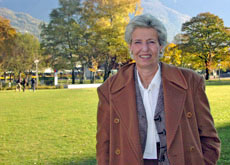Swiss women losing out in the workplace

Despite a high level of workforce participation, the majority of Swiss women only work part-time and there are few to be found at top management level.
Management consultant Sonja A. Buholzer explains to swissinfo where the shortcomings are and what is at stake.
The latest figures on workforce participation published by the Federal Statistics Office show once again that Switzerland is successful at attracting people into work.
In comparison with the European Union and the other industrialised countries, Swiss women are well represented in the workforce.
Just under three-quarters of working-age women in Switzerland are in employment, placing the country just behind the exemplary Scandinavian states.
swissinfo: Can Swiss women rest on their laurels now that they have risen above the European average in the working world?
Sonja A. Buholzer: That’s something neither men nor women can do. The high female participation rate may look good but has to be compared with just four per cent of women in management roles and less than 0.4 per cent presence of women at directorship level.
Not to mention that the average female salary is 20 per cent lower than their male co-workers and that women work much more on a part-time basis. The high rate of women in the workplace should only be interpreted in this context.
swissinfo: What is your take on the situation?
S.A.B.: In Switzerland we need to not just make gains in the numbers of women working but also bring greater numbers of them up to management levels. The active population is set to shrink by 2050, while the demand for more qualified labour will increase.
Successful companies in Switzerland have publicly committed themselves to this goal and they are driven by market considerations rather than feminist ideology.
It is a battle for the best not a battle between the sexes.
That’s why we need equal opportunities. This principle, along with family friendly policies, is no longer an optional extra but an obligation. Skills are not dependent on gender.
swissinfo: On the subject of equal opportunities, has the high female participation rate not been driven up by foreign women who have to work?
S.A.B.: Whether they are foreign or not is irrelevant. What counts is that 57 per cent of these women only work part-time.
It is well known that part-time jobs rarely open up career opportunities, even qualified ones. In this way Switzerland is losing many talents and strengths in competition with other countries.
swissinfo: The rise in the female participation rate is accompanied by a fall in male participation. In Europe by contrast this is increasing. Are women slowly taking men’s place in Switzerland?
S.A.B.: There are only two female factors that would put a man’s job under threat. Firstly, if a woman is at least as good, then she can compete on a level playing field.
Secondly, she can outdo a man because she can undercut his salary. Statistics show that as a woman she will receive on average 20 per cent lower pay for the same work. That’s where the salary discrimination against women comes back on men.
swissinfo: So what is this politicised job market and working world really about?
S.A.B.: It is no longer about the male-female debate, but about choosing the best, the most capable and career-oriented person.
It’s about fair competition in the job market. And it’s also about the use of unexploited female potential and reducing the damage done by outdated prejudice in the economy and politics.
swissinfo: But does it make sense to exhaust the full female potential if that means less children being born in the country?
S.A.B.: Fair competition in the job market includes the provision of family-friendly work models for men and women.
The absent father phenomenon will be undermined with flexible working hours and new career models for men and women. Couples should be able to plan their own solutions to meet the demands of career and family.
This is an attractive departure from gender stereotypes and the beginning of a new flexibility in work and family responsibilities.
If this doesn’t work, women’s “baby strike” could indeed put the future of modern civilisation in doubt.
swissinfo-interview: Alexander Künzle
Between 2001 and 2005, the rate of female participation in the Swiss workforce rose from 73.2% to 74.7%.
In 2006 45.9% of all employed people were women.
57.9% of women in Switzerland work part-time (EU 32.4%).
85.8% of women in Switzerland work in the service sector.
The number of part-time working women is increasing in all European workforces. The rate between 2001 and 2006 went up by 8.2% in Switzerland and 17.8% in the EU.
In the same time period the number of full-time working women only increased by 1.4% in Switzerland (2.6% in the EU).
As the owner of the management consultancy firm Vestalia Vision, Buholzer has a doctorate in philosophy and trained as a manager.
She was in charge of the international training section of a large bank, going on to head up the training department of a Swiss bank.
In 1994 the former bank director founded Vestalia Vision and began to advise business and political leaders.
She is also a keynote speaker, business expert and author of several books.
Her professional strengths include leadership questions, communication and ethics.
In percentages, 2006
Iceland (men/women) 91/84
Sweden 82/78
Switzerland 88/75
Netherlands 83/70
Britain 82/69
Germany 81/68
France 75/63
EU 25 78/62
Italy 75/51

In compliance with the JTI standards
More: SWI swissinfo.ch certified by the Journalism Trust Initiative











You can find an overview of ongoing debates with our journalists here . Please join us!
If you want to start a conversation about a topic raised in this article or want to report factual errors, email us at english@swissinfo.ch.